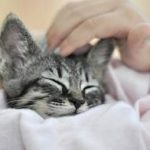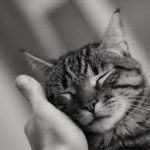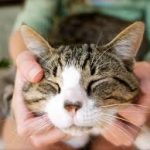 There is almost nothing more comforting than when a cat jumps on our lap and begins to purr. Ever since the Egyptians started worshiping the cat, philosophers, scientists and cat lovers worldwide have wondered why cats purr. When we hear and feel this purring, we assume that everything is purrfect with the cat. But why do cats purr? And what produces this sound?
There is almost nothing more comforting than when a cat jumps on our lap and begins to purr. Ever since the Egyptians started worshiping the cat, philosophers, scientists and cat lovers worldwide have wondered why cats purr. When we hear and feel this purring, we assume that everything is purrfect with the cat. But why do cats purr? And what produces this sound?
Purring is a mystery. No one can definitively say which mechanism in a cat creates the purr. Some feline experts believe purring is due to vibrations caused by blood passing through a large vein in the cat’s chest. Yet others who have studied purring think it’s due to the vibration of the vocal cords when the animal inhales and exhales.
 It turns out that cats have special wiring traveling from the brain to the muscles in the vocal cords. Nerve signals that pass through this wiring system cause vibrations of the vocal cords. While the nerves cause the vocal cords to vibrate, the air forced through them causes the musical hum. Since breathing has both inspiratory and expiratory phases, cats can purr continuously. The problem with this theory, however, is that cats continue to purr even when the nerves to the area of the vocal cords have been injured or damaged.
It turns out that cats have special wiring traveling from the brain to the muscles in the vocal cords. Nerve signals that pass through this wiring system cause vibrations of the vocal cords. While the nerves cause the vocal cords to vibrate, the air forced through them causes the musical hum. Since breathing has both inspiratory and expiratory phases, cats can purr continuously. The problem with this theory, however, is that cats continue to purr even when the nerves to the area of the vocal cords have been injured or damaged.
It is commonly believed that cats purr when content. However, cats also purr when they are severely injured, frightened or giving birth. According to some vets, the original function of the purr was to enable a kitten to communicate with his mother that things are going well. A kitten is able to purr by the second day of life, and although he can’t meow and nurse at the same time, he can purr and nurse.
Since the purr has lasted through hundreds of generations of cats, there must be a survival mechanism behind its continued existence. Researchers believe that self-healing is the survival mechanism behind the purr. There is extensive documentation that suggests that low frequencies, at low intensity, are therapeutic.
 Animal behaviourists believe that when cats purr under stressful circumstances, they are reassuring or comforting themselves, much as humans may sing to themselves or hum when they are nervous. Frightened cats may purr to communicate submissiveness or non-aggressive intentions. A feral cat may purr to signal that he is not planning to attack and other cats need not feel threatened. Older cats may purr when they play or approach other cats, signalling that they are friendly and want to come closer.
Animal behaviourists believe that when cats purr under stressful circumstances, they are reassuring or comforting themselves, much as humans may sing to themselves or hum when they are nervous. Frightened cats may purr to communicate submissiveness or non-aggressive intentions. A feral cat may purr to signal that he is not planning to attack and other cats need not feel threatened. Older cats may purr when they play or approach other cats, signalling that they are friendly and want to come closer.
Regardless o f the underlying reasons, I am so glad that cats purr, it is one of life’s pleasures to have a content cat purring close to you as you stroke it!
f the underlying reasons, I am so glad that cats purr, it is one of life’s pleasures to have a content cat purring close to you as you stroke it!
